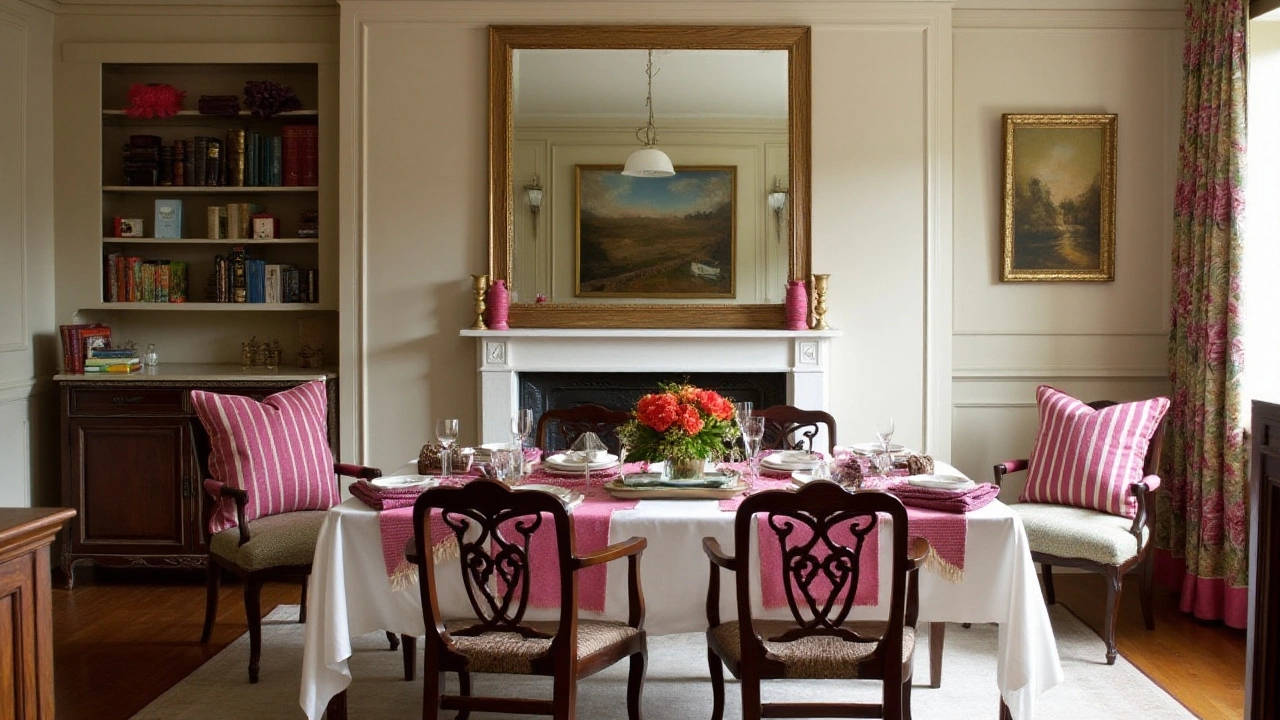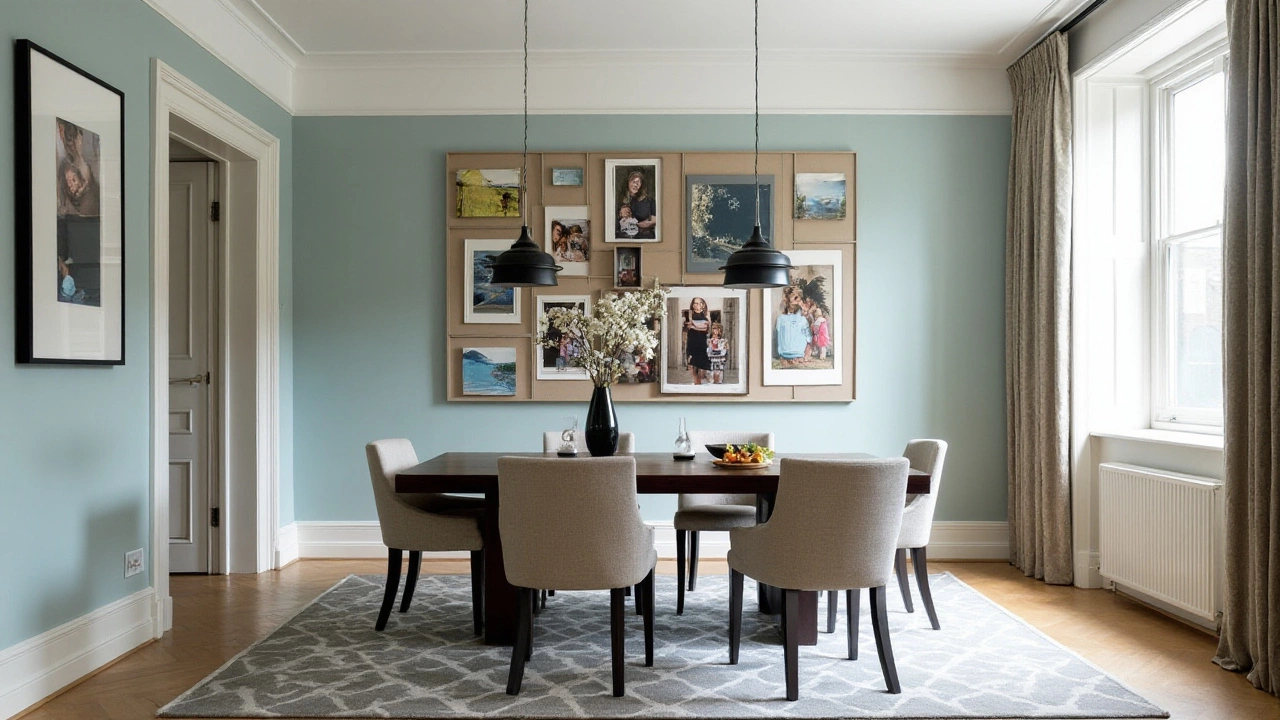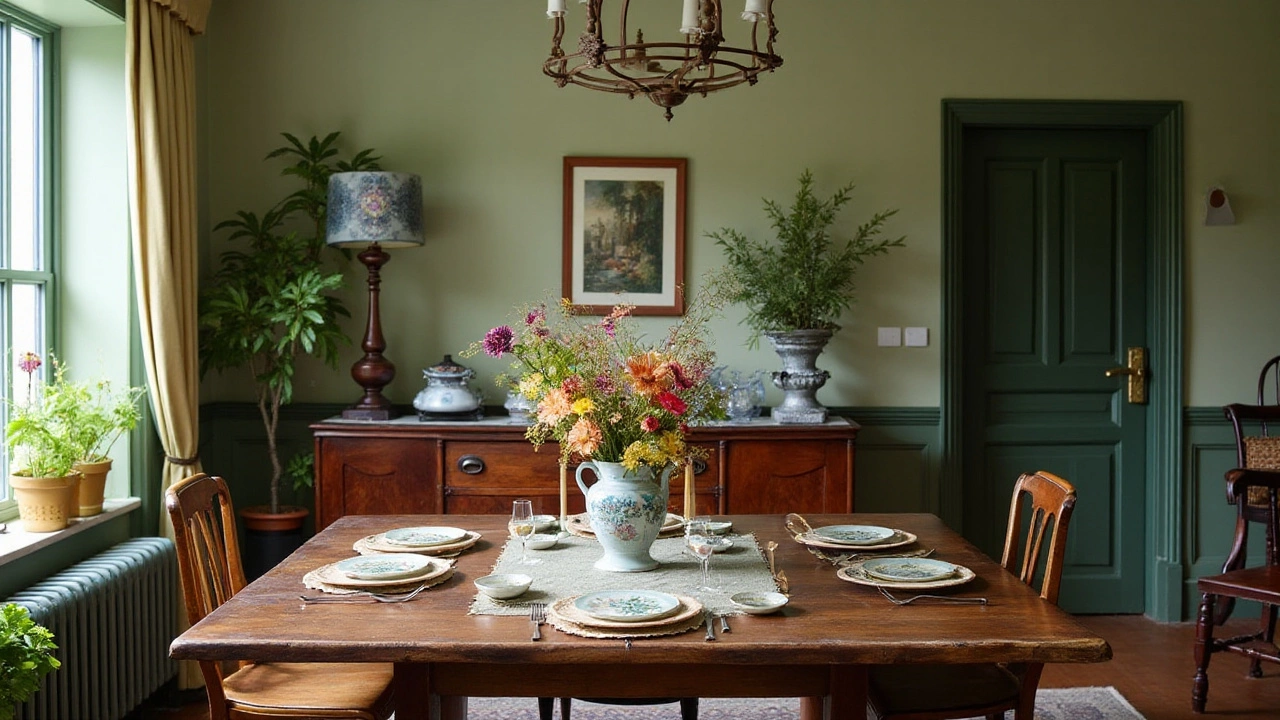Dark furniture can add a touch of elegance and sophistication to your dining room, making it a rich and inviting place to enjoy meals. But there's a tricky balance to strike, ensuring the space doesn't feel too dim or heavy. Fortunately, there are clever ways to counterbalance the darkness and make the room both welcoming and visually stimulating.
From amplifying natural light to choosing the right color palette, every design decision plays a significant role in how your dining room appears and feels. Let's explore a few creative approaches that can make any room with dark furniture glow with positive energy and light.
- Understanding the Influence of Colors
- Harnessing the Power of Natural and Artificial Light
- Incorporating Light-Colored Accents and Decor
- Choosing the Right Textiles and Accessories
Understanding the Influence of Colors
Colors are like magic in the world of interior design, silently shaping the space's mood and personality. In a dining area filled with dark furniture, the right color strategy is crucial to achieving the perfect balance between elegance and inviting warmth. Lighter shades, like soft whites, gentle creams, and pastel colors, when applied to walls or ceilings, can reflect more light, creating an illusion of a larger and airier room. This isn't just a guesswork. According to a study by paint experts, painting a ceiling white can increase the perceived height of the room by about 50 centimeters, giving a more open feel.
There's interesting psychology behind every shade you choose. Cool tones like blues and greens can add tranquility and calmness, which is essential in a dining space designed for relaxation and enjoyment. On the other hand, warm hues such as yellows and oranges can lead to an energetic and happy atmosphere, ideal for promoting lively conversation. Jazzing up the walls with these colors, even in subtle accents, can contrast with the depth of dark furniture, adding vibrancy without overpowering the sophistication that dark furniture brings.
It's also worthwhile to think about color harmony. Complementary colors, which sit opposite each other on the color wheel, can create a dynamic look that is visually stimulating. For instance, using a pale blue in a dining room with dark mahogany furniture creates a striking yet peaceful contrast. A notable designer once mentioned, "A room should never allow the eye to settle in one place. It should smile at you and create fantasy." — that was the renowned Juan Montoya, capturing the essence of dynamic color play.
Don't forget about the ceiling or floor, which are often overlooked areas. For the floor, consider light-colored rugs with patterns that incorporate the key shades used in your palette, giving cohesion to the room. As for the ceiling, a lighter color can draw the eye upward, making the entire space feel taller and less confined. These color strategies are not just about aesthetics but also about making every corner of the room functional and pleasant without compromising on style.

Harnessing the Power of Natural and Artificial Light
Lighting plays a vital role in setting the mood of a room, initially determining whether your dining space feels airy and welcoming or cramped and heavy. Natural light is the best friend of any room with dark furniture because it brings life and energy into the space. Begin by ensuring that your windows are allowing as much sunlight as possible to flood in. This might mean reconsidering heavy drapery in favor of lighter materials or sheer curtains. Reflective surfaces like mirrors strategically placed to catch and bounce natural light can significantly enhance the brightness. You could place these mirrors opposite windows or art pieces to reflect beautiful views or intriguing colors.
When it comes to artificial lighting, a layered approach is often most effective. Incorporate a mix of overhead lighting, such as chandeliers or pendant lights, alongside floor lamps and table lamps. These different light sources should work together to disperse light evenly across the room, eradicating shadows which often make spaces look smaller. Smart lighting systems can also be beneficial, allowing you to adjust the intensity of the light at different times of day to suit your mood or occasion. Adding LED strips under tables or cabinets can create an interesting visual element while also serving to lighten darker corners of the room.
The renowned designer David Hicks once said, "Good lighting is the key to good interior design." This couldn't be more true when you're battling with dark furniture in small spaces.
Temperature of the light is another factor to consider; warmer tones tend to create a cozy atmosphere, while cooler tones are vibrant and energizing. Think of the light bulb not just as a functional piece but as a critical design element – there are numerous options like Edison bulbs for a vintage charm or sleek, modern LEDs. For those who enjoy entertaining, dimmable options can offer flexibility, setting the perfect mood for an intimate dinner or a lively party. Lastly, don't forget to regularly clean your light fixtures and bulbs as dust can dull their brightness over time, impacting the overall illumination of your dining area.

Incorporating Light-Colored Accents and Decor
The allure of dark furniture in a dining room lies in its ability to exude a timeless charm. Yet, without the right balance, such furniture can make a room feel heavy or dim. Enter the magic of light-colored accents and decor, which can transform a somber space into a lively sanctuary. Incorporating these elements helps in bouncing the light around effectively, adding the vibrancy that so many dining spaces crave. Whether it's choosing the right set of placemats, picking out an elegant vase, or selecting the perfect cushion covers, the choices are plentiful and can make a substantial impact. Imagine setting a table with pristine white crockery; those small touches can work wonders by contrasting against the dark wood, creating an immediate sense of brightness.
One effective strategy is to look at the walls. Painting them in cool shades like pastel blue or mint green, or even warm creams, can immediately uplift the setting. If painting isn't an option, consider hanging wall art that features lighter hues. A striking piece with a predominantly white or cream background can catch the eye, serving as a focal point against the deeper furniture. Wall mirrors can also do the trick, reflecting both light and other elements around the room, thereby giving an illusion of increased space. For a bolder approach, indulge in an accent wall with soft-patterned wallpaper; options are endless when it comes to enlivening your dining area.
Expressing your personality through decor is how a space truly becomes your own. Think of light-colored vases filled with fresh seasonal flowers like daisies or lilies, their natural brightness providing contrast and life. Curtains in soft colors can also break the color monotony, and when pulled aside, let in the natural light, further illuminating the dark furniture. In a delightful quote by interior designer Kelly Wearstler, she mentions, "The essential aspect of interior design will always be about people and how they live. It is the quality of space and how it nurtures the mood." The key is to curate pieces that provide both contrast and cohesion, maintaining the aesthetic integrity of your dining space.
When you think about textures, don't forget the power of lighter textiles. Rugs in neutrals or pastels under the dining table not only define the space but also add depth and texture without overwhelming. Lighter table linens, like those woven from breezy fabrics in whites or creams, invite you to enjoy a meal surrounded by serenity. Consider light-toned ceramic or porcelain decor items which offer a matte, reflective surface, subtly enhancing the brightness of your surroundings. It’s these detailed touches that add layers and dimension, making the space feel curated and personal.
Finally, consider the seashell trick used by designers: placing clusters of candles in glass holders or hurricanes on the dining table or sideboard. When lit, they cast a warm glow that dances off the dark furniture, adding a sense of warmth and occasion. Lanterns, fairy lights, or a stylish white chandelier can draw the eye upward, creating height and drama. In these ways, light and dark aren't adversaries but partners in creating a harmonious dining room. So embrace this charming play of contrasts, and with a few light-colored accents and decor, make your dining room a radiant space where both style and warmth coexist seamlessly.

Choosing the Right Textiles and Accessories
When it comes to brightening a dining room sporting dramatic dark furniture, selecting the correct textiles and accessories can work wonders. The colors, textures, and patterns surrounding can alter its mood significantly. Start by considering lighter shades for elements like tablecloths, curtains, and chair cushions. Light, airy fabrics like linen and cotton not only diffuse light beautifully but also bring a fresh, open feel to the area. The key is picking hues that contrast gently with the deep tones of the furniture, perhaps opting for creamy whites, soft pastels, or even muted metallics. These tones can reflect light and create a bright, expansive impression.
Texture can also add depth and interest, making the space feel more layered and complex. Mix and match pieces with different textures - such as a sleek satin runner with a nubby woolen throw. This juxtaposition can make the area work more dynamic, enhancing rather than overriding its elegant furniture. Accessories like shimmering vases or gleaming silverware can reflect light too, often contributing to a room's brightness. It's fascinating how the interplay of various materials and finishes works unnoticed, impacting how we perceive light and space.
A well-known interior designer, Julianne Malcovich, once noted, "The beauty of decorating a room lies not only in what you include but in how these pieces complement each other to tell a story of comfort and elegance." Remember, every vase or picture frame is an opportunity to lighten and enliven your dining room.
Consider incorporating mirrors and glass items strategically. These can amplify your lighting by reflecting it around the space. A beautiful mirrored wall or artwork can both reflect and enhance illumination, transforming dark nooks into cozy, radiant corners. You might also use decorative glass bowls filled with bright, colorful accessories, or perhaps fresh flowers, to add a dash of liveliness to your dining room setup.
Another aspect not to forget is the floor covering. Rugs in lighter tones with engaging patterns could add a sense of movement and wideness, contrasting nicely with darker furniture legs. A fun trick is to match small elements in the rug's design with the room's existing palette to pull the room together cohesively. For instance, if your furniture has a mahogany finish, a rug with soft, warm accents could harmonize beautifully without overshadowing it. This approach ensures a room feels adequately tied together style-wise, delivering both warmth and lightness.
 EN
EN
 HR
HR
 AR
AR

